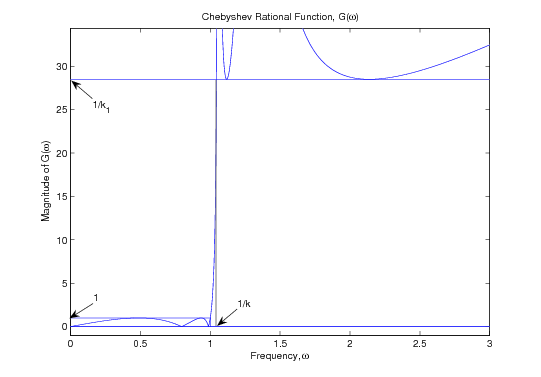| << Chapter < Page | Chapter >> Page > |
which, on removing the parameter , become
or
These relationships are central to the design of elliptic- function filters. is an odd integer which is the order of the filter. For , the resulting rational function is shown in [link] .

This function is the basis of the approximation necessary for the optimal filter frequency response. It approximates zero over thefrequency range by an equal-ripple oscillation between . It also approximates infinity over the range by a reciprocal oscillation that keeps . The zero approximation is normalized in both the frequency range and the values to unity. The infinity approximation has its frequency range set by the choice of the modulus , and the minimum value of is set by the choice of the second modulus .
If and are determined from the filter specifications, they in turn determine the complementary moduli and , which altogether determine the four values of the complete ellipticintegral needed to determine the order in [link] . In general, this sequence of events will not result in an integer. Inpractice, however, the next larger integer is used, and either or (or perhaps both) is altered to satisfy [link] .
In addition to the two-band equal-ripple characteristics, has another interesting and valuable property. The pole and zero locations have a reciprocal relationship that can be expressedby
where
This states that if the zeros of are located at , the poles are located at
If the zeros are known, the poles are known, and vice versa. A similar relation exists between the points of zero derivatives inthe 0 to 1 region and those in the to infinity region.
The zeros of are found from [link] by requiring
which implies
From [link] , this gives
This can be reformulated using [link] so that and are not needed. For odd, the zero locations are
The pole locations are found from these zero locations using [link] . The locations of the zero-derivative points are given by
in the 0 to 1 region, and the corresponding points inthe 1/k to infinity region are found from [link] .
The above relations assume N to be an odd integer. A modification for N even is necessary. For proper alignment of thereal periods, the original definition of is changed to
which gives for the zero locations with N even
The even and odd N cases can be combined to give
for
with the poles determined from [link] .
Note that it is possible to determine from k and N without explicitly using or . Values for and are implied by the requirements of [link] or [link] .
The locations of the zeros of the filter transfer function are easily found since they are the same as the poles of , given in [link] .
for

Notification Switch
Would you like to follow the 'Digital signal processing and digital filter design (draft)' conversation and receive update notifications?